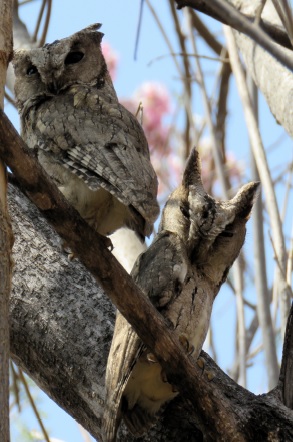TIME: 6.45 to 8.45 AM
ROUTE: First bridge, old mango grove and Malli Baavi
OBSERVERS: Nirvedh, Nirad, Yash, Pranav, Arjun, Jyothi and Santharam
WEATHER: Pleasant. Cloudy with hazy sun.
55 species seen today. The weather being pleasant, it was a pleasure being outdoors this morning. An unusual bird spotted this morning was the Tickell’s Blue Flycatcher. A single bird was noticed behind the Alumni Guest House. We have seen it here only once earlier on the campus. It is, however, a fairly common bird in the Horsley Hills.
BIRD LIST (INCLUDING CALLS)
House Crow
Large-billed Crow
Red-rumped Swallow
Cinereous Tit (Great Tit)
Red-vented Bulbul
Red-whiskered Bulbul
White-browed Bulbul
Greenish Warbler
Blyth's Reed Warbler
Common Tailorbird
Ashy Prinia
Tawny-bellied Babbler
Yellow-billed Babbler
Indian Robin
Oriental Magpie-Robin
Tickell's Blue Flycatcher
Verditer Flycatcher
Pied Bushchat
Common Myna
Jerdon's Leafbird (Jerdon's Chloropsis)
Pale-billed Flowerpecker
Purple-rumped Sunbird
Purple Sunbird
Long-billed Sunbird (Loten's Sunbird)
Tree Pipit
Baya Weaver
Scaly-breasted Munia (Spotted Munia)
Grey Francolin
Rock Pigeon (Feral Pigeon)
Spotted Dove
Greater Coucal
Asian Koel
Little Swift (Indian House Swift)
Cattle Egret
Shikra
Spotted Owlet
Eurasian Hoopoe
Indian Grey Hornbill
White-throated Kingfisher
Green Bee-eater
Coppersmith Barbet
White-cheeked Barbet (Small Green Barbet)
Black-rumped Flameback
Rose-ringed Parakeet
Common Woodshrike
Common Iora
Small Minivet
Large Cuckooshrike
Black-naped Oriole
Black-hooded Oriole
Black Drongo
Ashy Drongo
Hair-crested Drongo (Spangled Drongo)
Indian Paradise-Flycatcher
Rufous Treepie











